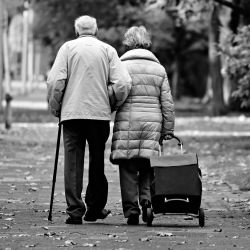By Chuck Dinerstein, MD, MBA — March 23, 2021
It costs considerably more to live in an assisted-living setting than to remain at home. But our healthcare system frequently doesn’t address the changes to the “infrastructure” necessary to allow individuals to access that option. We are, at best, being “penny wise, pound foolish.” And, at worst, we’re placing the elderly in less hospitable environments.
As we age, our abilities inevitably decline. The activities of daily livings (ADLs) capture those skills we need to remain living an independent life – primarily getting dressed, bathing and toileting, and eating meals. Bathing and hygiene are particularly crucial – simply put, if you cannot bathe and use the toilet where you are, you need to be somewhere else. Simple home modifications, a grab bar in the shower or tub, an elevated toilet seat, a shower seat all are inexpensive additions that
“reduce injury, enable independence, preserve dignity, and improve quality of life in older people with irreversible disability for complex multifactorial reasons.”
Those simple modifications can reduce falls by 19% and increase independence by 30%, translating into considerable savings to the healthcare system over the cost. It should come as no surprise that this is another area where we may have failed “our seniors.” Here are findings from a new study reported this week in JAMA Internal Medicine.
The research utilized the National Health and Aging Trends Study (NHATS) which annually, interviews a sample of Medicare beneficiaries over the age of 65. [1] The data consists of information determined at both the 2015 and 2019 interviews. More specifically, in addition to the usual demographics, the researchers gathered information on the beneficiary’s ADLs and any subsequent help they might have received in the ensuing four years.
Of the 7070 community-dwelling interviewees, 2614 or 37% had sufficient disability to warrant home modification – a cost not covered by Medicare, which readily covers the cost of a walker in the presence of mobility impairment. Mean age was 80.5, two-thirds women, 25% Black, 7% Hispanic. The majority (65%) owned their home, and 80% lived in a metropolitan area. 40% were living with their spouse, and 40% had some college or more education.
- 42% had an unmet need for equipment for bathing or toileting
- For bathing, 26% had no equipment, and 33% had only one of two modifications
- For toileting, 44% had no equipment, and 32% had just one of two modifications
That unmet need is significant, especially when you consider that it really reflects unmet preventative care. In the four subsequent years, 52% of those in need of toileting equipment and 35% of those needing bathing equipment received nothing. Among the disparities, our woke term for differences, the researcher identified:
- Younger individuals were more likely to lack equipment
- Minority groups lacked equipment
- The provision of assistive devices was piecemeal; you never got all of what you needed at once.
Why would this be?
While the result appears to be “penny wise, pound foolish,” the reality is more likely that these needs were invisible. First, there is some stigma needing this kind of help, an unwarranted shame that prevents us from sharing our needs. When patients come to the attention of the healthcare system, we do act. Individuals with walkers, who were presumably seen and care for after an injury or hospitalization, were more likely to have the other necessary assistive devices – the investigation into their mobility leads had considered all of their activities of daily living. Unfortunately, seeing a physician is no guarantee. 98% of these participants had seen their physician, but as the researchers write:
“few physicians are skilled at identifying incident disability in their older patients, asking screening questions about home environments, educating patients on available options, making recommendations, and routing patients to solutions.”
Finally, navigating the byzantine healthcare system is not for the weak, as the national headlines for getting a COVID-19 vaccination demonstrate. The journey from recognizing a need to prescribing a device to actually getting or installing this equipment can take weeks and involves lots of paper and approvals. You need help. Unfortunately, at the end of your journey, these devices are all out-of-pocket expenses. Doesn’t it seem wrong to pay for a walker, but not for a toilet seat, or to have a grab bar installed? Compared to the cost of assisted living or the hospitalization associated with a broken hip, it is a small price to pay, a price we should pay.
Source: Unmet Need for Equipment to Help With Bathing and Toileting Among Older US Adults JAMA Internal Medicine DOI: 10.1001/jamainternmed.2021.0204
Home Safety Services can help you with all of your falls prevention and home modification needs. Contact us today.

